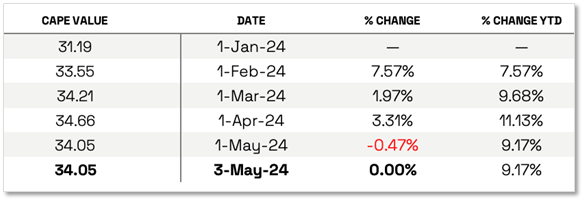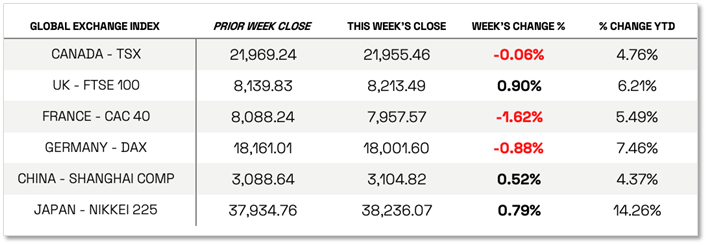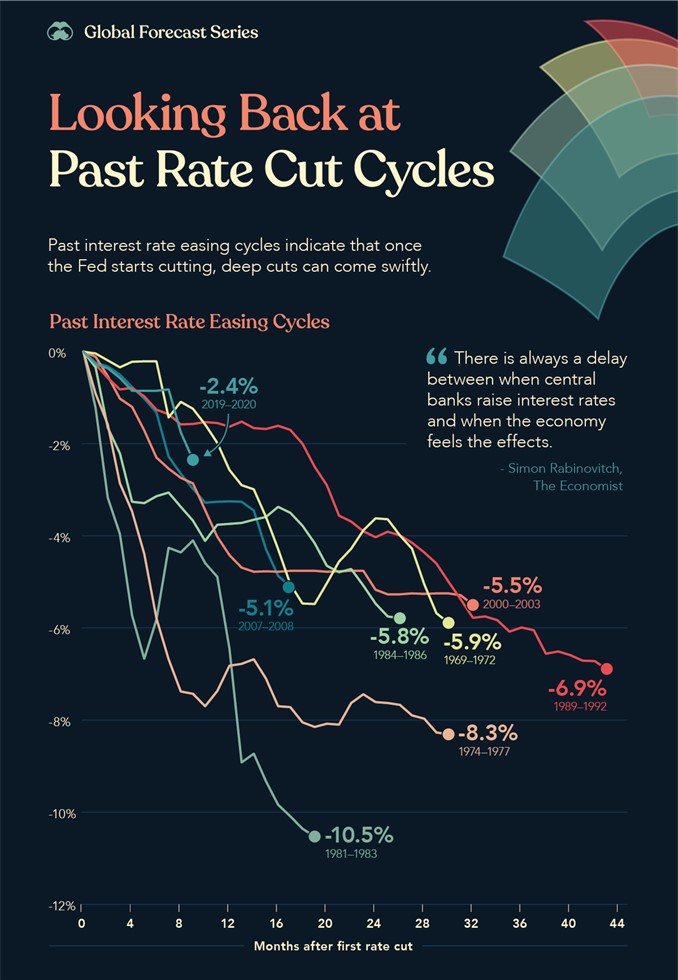
Market Update 05-06-2024
THE BIG PICTURE:
Counting-up of the number of all our indicators that are ‘Up’ for U.S. Equities, the current tally is that all of the four are Positive. These represent a multitude of timeframes:
- LONG-TERM CYCLICAL BULL/BEAR — POSITIVE since April 21, 2023
- MIDTERM/QUARTERLY — POSITIVE since January 1, 2024
- SHORT-TERM — POSITIVE since November 16, 2023
- SHORT-TERM — POSITIVE since November 21, 2023
LAST WEEK IN THE MARKETS
STARTING WITH A DOMESTIC OVERVIEW
LATE RALLY LIFTS SMALL-CAPS BACK INTO POSITIVE TERRITORY FOR 2024
Stocks ended higher following a volatile week featuring a raft of economic and earnings data. Growth stocks outperformed value shares, which were flat overall for the week. Small-caps outpaced large-caps, helping lift the small-cap Russell 2000 Index back into slightly positive territory for the year-to-date period.
It was the second-busiest week of first-quarter earnings reports, and a positive reception to Apple’s earnings release after the close of trading on Thursday seemed to help drive a rebound in overall sentiment. The company beat consensus revenue expectations, but investors also appeared enthused by Apple’s announcement that it would buy back USD 110 billion of its own shares, the largest such repurchase in history. Another notable mover for the week was Tesla, which surged over 15% on Monday after founder Elon Musk made a surprise appearance in China following news of the government’s tentative approval of the self-driving technology the company has under development.
U.S. MARKET INDEXES OVERVIEW
Indexes continued to see positive momentum this week, albeit a lighter growth week vs the end of April. Small-cap led the way this week closing in on 2% gains and is now back above negative YTD territory.
DOW & TECH
THE DOW JONES INDUSTRIAL AVERAGE (DJIA) is the oldest continuing U.S. market index with over 100 years of history and is made up of 30 highly reputable “blue-chip” U.S. stocks (e.g. Coca-Cola Co., Microsoft).
- The Dow continued its upward trend this week with over 1% growth – more than last week’s lifts. By market-close this week, the DJIA, gained 1.14%, ending the week of May 3 at 38,675.68 vs the prior week of 38,239.66, now sitting at +2.62% YTD.
THE NASDAQ COMPOSITE INDEX tracks most of the stocks listed on the Nasdaq Stock Market - the second-largest stock exchange in the world. Over half of all stocks on the NASDAQ are tech stocks.
- The tech-driven Nasdaq, enjoyed steady gains of 1.43%, closing at 16,156.33 vs. the prior week of 15,927.90.
SMALL, MEDIUM, & LARGE CAP
THE S&P 500 LARGE-CAP INDEX is a market-capitalization-weighted index of 500 leading publicly traded companies in the U.S. The S&P 500 is regarded as one of the best gauges of prominent American equities' performance, and by extension, that of the stock market overall.
- The large-cap S&P 500 was the lightest growth this week with gains of 0.55%, closing at 5,127.79 vs last week’s close of 5,099.69 landing at 7.50% growth YTD.
THE S&P 400 MID-CAP INDEX is the benchmark index made up of 400 stocks that broadly represent companies with midrange market capitalization between $3.6 billion and $13.1 billion. It is used by investors as a gauge for market performance and directional trends in U.S. stocks.
- The S&P 400 mid-cap continued steady growth with the index gaining 1.46% by market close ending at 2,929.04 vs last week’s 2,886.89.
THE RUSSELL 2000 (RUT) SMALL-CAP INDEX measures the performance of the 2,000 smaller companies included in the Russell 3000 Index. The Russell 2000 is managed by London's FTSE Russell Group and is widely regarded as a leading indicator of the U.S. economy because of its focus on smaller companies that focus on the U.S. market.
- The Russel 2000 lead the indexes this week in growth – something it desperately needed to exit the negative YTD territory. RUT gained 1.68% closing at 2,035.75 vs last week’s close of 2,002.00 bring the small-cap index to a now-positive YTD growth of 0.43%.
U.S. COMMODITIES / FUTURES OVERVIEW
A continued decline for all 4 commodities tracked below. Gold and Silver both dropped closer to 2% with Copper joining the negative momentum this week. Crude Oil was the biggest change this week after a positive gain last week.
ECONOMIC NEWS
FOR THE U.S. MARKET
STOCKS RALLY ON SIGNS THAT WAGE PRESSURES ARE EASING
The main driver of the week’s gains appeared to be Friday morning’s nonfarm payrolls report, which showed that employers added 175,000 jobs in April, less than expected and the lowest number since November. While the miss signaled a cooldown in the labor market, and thus lower inflationary pressures, investors may have been more pleased by a surprise slowdown in monthly wage increases, from 0.3% in March to 0.2% in April. The year-over-year gain fell to 3.9%, the slowest increase in almost two years. Similarly, average weekly hours worked fell back slightly, while the unemployment rate climbed slightly to 3.9%.
The news may have been particularly welcome because it followed some upside inflation and (more distinct) downward growth surprises earlier in the week—a combination that added to recent worries over emerging “stagflation” trends. Stocks fell sharply on Tuesday after the Labor Department reported that employment costs rose 1.2% in the first quarter—or an annual rate of nearly 5%—which was above expectations and the fastest pace in a year. A separate report showed home prices rising in February at their fastest pace in eight months.
Meanwhile, a gauge of business activity in the Chicago area fell to its lowest level since November 2022, and the Conference Board’s measure of consumer confidence declined in April to its lowest point in nearly two years. The Labor Department’s tally of March job openings, reported Wednesday, fell more than expected to 8.5 million, the lowest level in over three years. On Friday, the Institute for Supply Management reported that its gauge of services sector activity had fallen back into contraction territory for the first time since December 2022.
POWELL PUSHES BACK ON STAGFLATION WORRIES
Investors seemed to take some encouragement the following day from Federal Reserve Chair Jerome Powell’s response to the data. In his press conference following the Fed’s two-day policy meeting, Powell pushed back against stagflation worries, stating that “I don't really understand where that's coming from” and citing current growth and inflation rates of around 3%. Powell also stressed that while policymakers were not prepared to cut rates—and rates were left steady at the meeting, as was widely expected—neither did they see the need to increase rates given the “sufficiently restrictive” current stance of monetary policy.
The evidence of a cooling jobs market helped push the yield on the benchmark 10-year U.S. Treasury note to an intraday low of around 4.45% on Friday morning, its lowest level in nearly a month. (Bond prices and yields move in opposite directions.) A subdued primary calendar further helped returns in the tax-exempt municipal bond market.
Issuance was relatively light in the investment-grade corporate bond market, and all issues were oversubscribed. Traders reported that, following a somewhat mixed start to the week, high yield bonds traded higher alongside equities in response to Powell’s relatively dovish press conference. Meanwhile, earnings reports continued to play a role in returns, while new deals that came to the market were generally met with solid demand.
LAST 52 WEEKS OF THE VOLITILIY INDEX (VIX)
VIX closed at 13.49 this week, a 10.52% decrease over last week’s close of 15.03.
THE CAPE THIS YEAR (2024)
34.05 – down this week -0.47% at the beginning of the month measured against April 1, 2024.
CAPE = cyclically adjusted price-to-earnings ratio (CAPE)
Note: We do not use CAPE as an official input into our methods. However, we think history serves as a guide and that it’s good to know where we are on the historic continuum.
INTERNATIONAL MARKETS
LOOKING AT THE GLOBAL PICTURE
EUROPEAN OVERVIEW
In local currency terms, the pan-European STOXX Europe 600 Index ended 0.48% lower. Investors appeared to become more cautious amid mixed corporate earnings and uncertainty surrounding the outlook for interest rates after June. Major stock indexes were mixed. Germany’s DAX weakened 0.88%, France’s CAC 40 Index lost 1.62%, and Italy’s FTSE MIB declined 1.81%. The UK’s FTSE 100 Index, however, added 0.90%, driven to a fresh high by strength in mining and energy stocks.
European government bond yields generally declined, as policymakers downplayed growing concerns about the potential further interest rate increases by major central banks. The yield on the German 10-year government bond fell toward 2.5%, while the yield on 10-year UK government bonds also eased.
EUROZONE ECONOMY PICKS UP FROM RECESSION; CORE INFLATION SLOWS
Eurozone gross domestic product surprised to the upside, expanding 0.3% in the first quarter, after shrinking 0.1% in the final three months of 2023. The contraction registered in the fourth quarter of 2023 was a downward revision from 0.0%, meaning that the economy fell into a technical recession in the second half of last year. Meanwhile, annual consumer price growth was steady in April at 2.4%, but core inflation—which excludes energy and food prices—slowed to 2.7% from 2.9%.
European Central Bank (ECB) policymaker and Bank of France Governor François Villeroy de Galhau said that the latest data strengthened confidence that inflation would return to the 2% target by next year, suggesting that the ECB should be able to start lowering borrowing costs in June.
UK HOUSING MARKET RECOVERY SLOWS
Mortgage lenders in the UK approved 61,325 mortgages in March, up from 60,497 in February, according to the Bank of England. The increase to an 18-month high provided further evidence that the housing market began to recover this year. Still, the Nationwide Building Society’s house price index for April fell 0.4% sequentially, the second consecutive monthly decline and a sign that activity may be moderating.
NORGES BANK KEEPS RATES UNCHANGED
The Norwegian central bank held its key interest rate at 4.50%, saying it might have to keep borrowing costs higher for longer than previously envisaged to quell inflation.
JAPAN
As perceptions grew that Japanese authorities had intervened in the foreign exchange markets twice during the week to prop up the yen, Japanese stocks generated positive returns, with the Nikkei 225 Index rising 0.8% and the broader TOPIX Index gaining 1.6%. Changes in the Bank of Japan’s (BoJ’s) accounts suggested that such interventions had taken place, although the authorities refrained from confirming that they had finally acted with a view to halting the Japanese currency’s historic slump. The yen strengthened to around JPY 153 against the USD, from about JPY 158 at the end of the previous week.
Despite some intraweek volatility, the yield on the 10-year Japanese government bond finished the week broadly unchanged at the 0.9% level, near a six-month high. This was within the context of strong U.S. wage data raising concerns that the Federal Reserve will keep interest rates higher for longer. In March, the BoJ lifted interest rates from negative territory for the first time in seven years—with many now anticipating two further rate hikes within roughly a one-year period. Nevertheless, Japan’s monetary policy remains among the most accommodative in the world, and financial conditions are expected to remain accommodative also, for the time being.
CORPORATE EARNINGS BENEFIT FROM WEAK YEN, PRICE HIKES, TOURISM STRENGTH
On the corporate news front, the latest earnings season saw more than two-thirds of Japan’s large public companies report higher profits, according to an analysis of company earnings releases by the Nikkei news organization. Generally, solid profit growth was attributable to a range of factors including yen weakness, price hikes, and a rebound in inbound tourism. Many companies also felt the positive impact of developments relating to generative artificial intelligence (AI). However, some companies faced headwinds in the form of increased competition, particularly in China, and the negative effects of currency depreciation.
CHINA
Chinese stocks rose in a holiday-shortened week on hopes that the government will ramp up support. The Shanghai Composite Index gained 0.52%, while the blue chip CSI 300 edged up 0.56%. In Hong Kong, the benchmark Hang Seng Index added 4.67%, according to FactSet. Markets in mainland China were closed from Wednesday for the Labor Day Holiday and will reopen on Monday, May 6. Hong Kong markets were closed Wednesday but reopened Thursday.
China’s top decision-making body, the 24-member Politburo, pledged to implement prudent monetary and fiscal support to shore up demand at its April meeting last Tuesday. Officials stated that China would make flexible use of monetary policy tools to restore growth, including possible cuts to interest rates and the reserve requirement ratio, which sets the amount of cash that banks must set aside in reserve.
MANUFACTURING CONTINUES TO EXPAND
The official manufacturing Purchasing Managers’ Index (PMI) was a better-than-expected reading of 50.4 in April, down from March’s 50.8, marking the second straight monthly expansion. The nonmanufacturing PMI reached a below-consensus 51.2, easing from 53 in March, as new orders and services activity stalled from the prior month. Separately, the private Caixin/S&P Global survey of manufacturing activity edged up to a better-than-expected 51.4 in April, marking its 16th month of expansion.
Slowing industrial profits growth pointed to deflationary pressures that continue to weigh on China’s economy. Profits at industrial firms declined in March and advanced 4.3% in the first quarter of 2024 year over year, slowing from a 10.2% gain in the January to February period, according to the National Bureau of Statistics.
PROPERTY CRISIS PERSISTS
The value of new home sales by the country’s top 100 developers slumped 45% in April from the prior-year period, in line with March’s decline, according to the China Real Estate Information Corp. Transactions fell by 13% from the previous month. China’s housing downturn, now in its fourth year, remains a significant drag on the economy, as it has made consumers reluctant to spend and left developers with a massive supply of unfinished apartments.
HIGHLIGHT OF THE WEEK:
Past Interest Rate Cut Cycles and 2024 Rate Cut Forecasts
https://www.visualcapitalist.com/visualized-past-interest-rate-cut-cycles-and-2024-forecasts/
JANUARY 31, 2024
A key question mark for the U.S. and global economy is around when the Federal Reserve will cut interest rates in 2024 and by how much.
After a rapid set of rate hikes throughout 2022, the U.S. Federal Reserve now faces the challenge of timing its easing of monetary policy to ensure a soft landing for the economy.
This visualization from our 2024 Global Forecast Series uses data from the Federal Reserve to chart past interest rate cut cycles and visualizes forecasts by top banks and institutions on when they expect the first rate cut of 2024 and the number of cuts they expect by end of year.
Looking Back at Past Interest Rate Cuts Cycles
While interest rate cycles are an economic balancing act which must be carefully managed, rate hikes and cuts of the past have typically been steep and swift.
Looking back at past interest rate cuts for historical context, we can see how quickly these easing cycles played out, especially those in the 1970s and 1980s.
Rate cuts typically begin once the Federal Reserve has confirmation that the economy has slowed down and inflationary pressures have subsided. Nearly every interest rate cutting cycle has seen the economy enter a recession right before or after rate cuts have started.
“There is always a delay between when central banks raise interest rates and when the economy feels the effects.”
– Simon Rabinovitch, The Economist
While the recessions occur around the time rates are cut, they’re usually a delayed effect from the tighter financial conditions caused by rate hikes, with cuts bringing looser and more accommodative financial conditions for the economy down the line.
While nearly every interest rate cycle of the past has experienced a recession around the time of rate cuts, Federal Reserve Chair Jerome Powell is optimistic that this time may be different.
“I have always felt, since the beginning, that there was a possibility, because of the unusual situation, that the economy could cool off in a way that enabled inflation to come down without the kind of large job losses that have often been associated with high inflation and tightening cycles. So far, that’s what we’re seeing.”
– Jerome Powell, Chair of the U.S. Federal Reserve
Only time will tell whether the path the Fed chooses this year will manage to keep the economy out of a recession.
Sources:
All index and returns data from Norgate Data and Commodity Systems Incorporated and Wall Street Journal News from Reuters, Barron’s, Wall St. Journal, Bloomberg.com, ft.com, guggenheimpartners.com, zerohedge.com, ritholtz.com, markit.com, financialpost.com, Eurostat, Statistics Canada, Yahoo! Finance, stocksandnews.com, marketwatch.com, visualcapitalist.com, wantchinatimes.com, BBC, 361capital.com, pensionpartners.com, cnbc.com, FactSet, Morningstar/Ibbotson Associates, Corporate Finance Institute. Commentary from T Rowe Price Global markets weekly update — https://www.troweprice.com/personal-investing/resources/insights/global-markets-weekly-update









